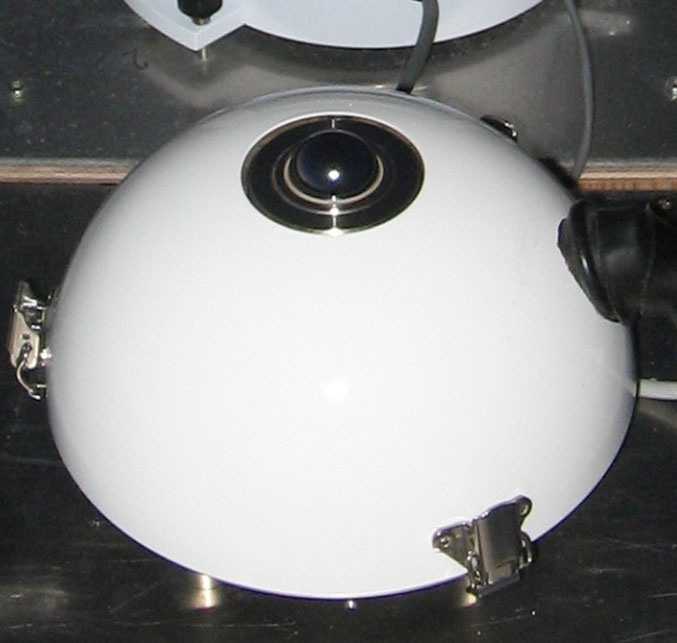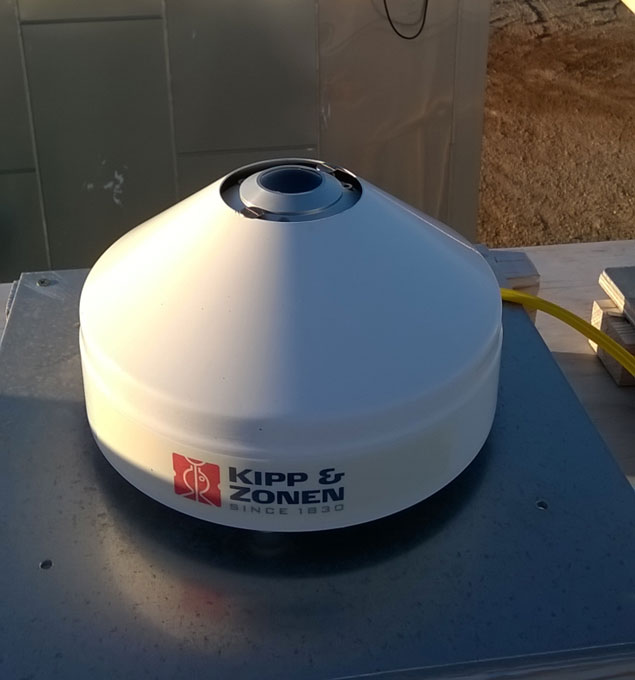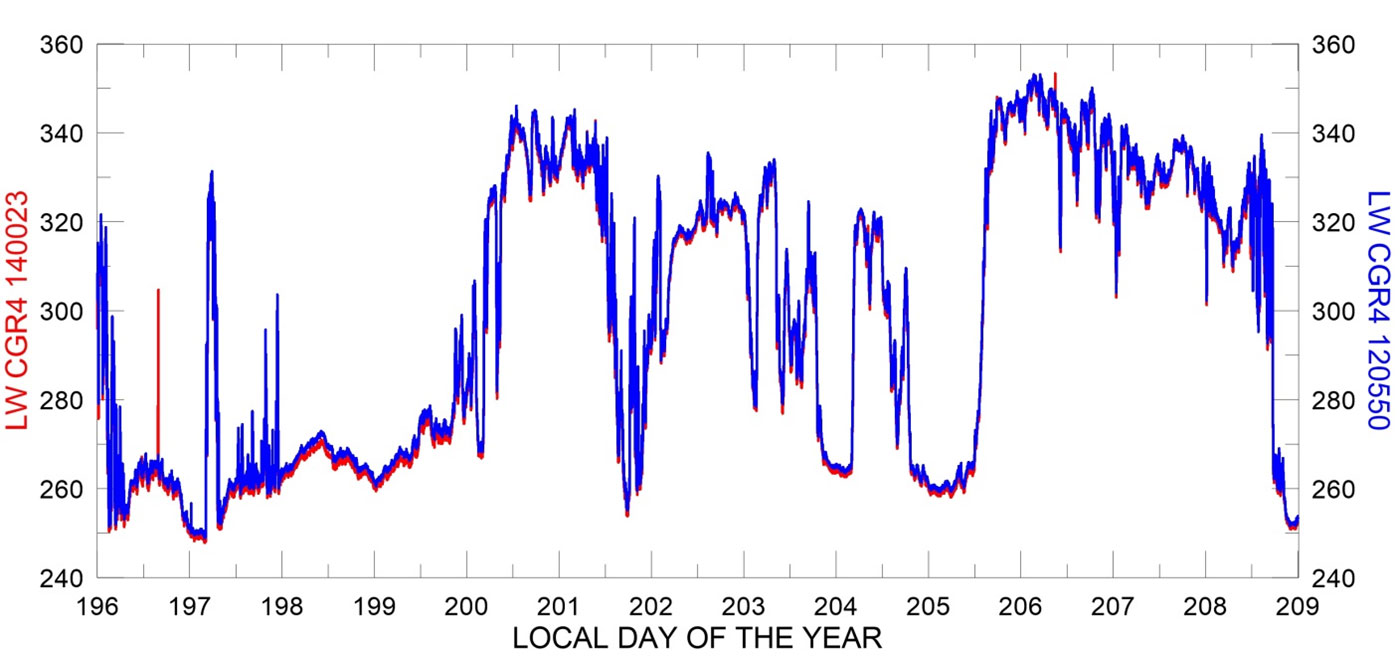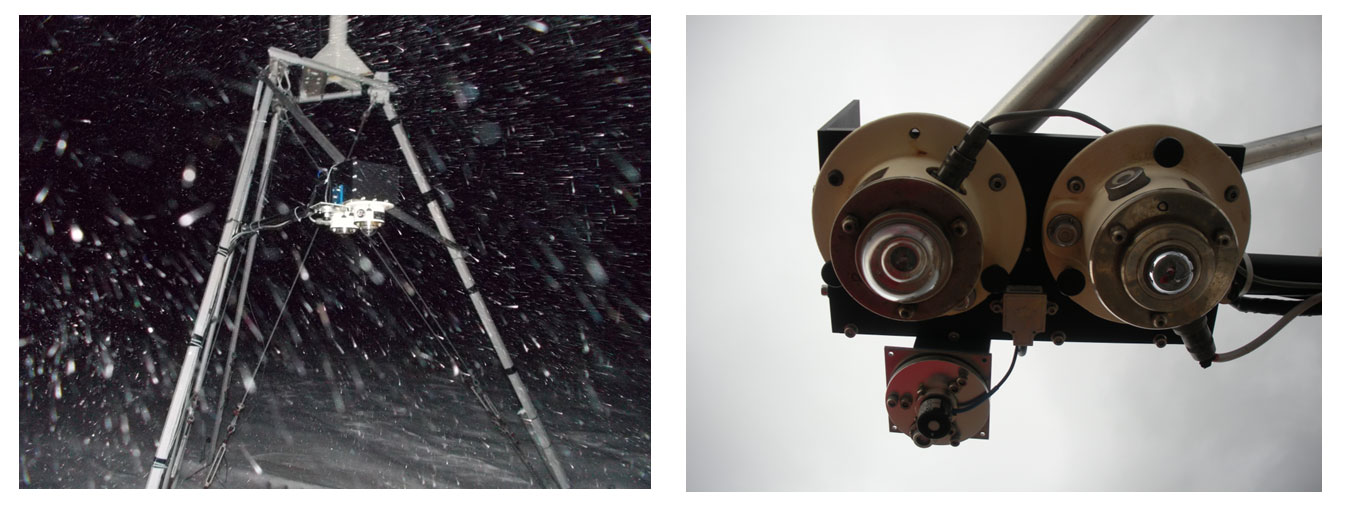Instruments:
Shortwave and longwave broadband radiometers
PI: Daniela Meloni email:daniela.meloni@enea.it
Measurements of downward broadband shortwave irradiance (DSI) and longwave irradiance (DLI) started at Thule on January 2009 by means of an Eppley Precision Spectral Pyranometers (PSP) and Precision Infrared Pyranometer (PIR), respectively.
The PSP (Fig. 1) is a WMO First Class Radiometer: the sensor is a thermopile covered by a pair of removable hemispheres of Schott optical glass,
transparent to radiation between 0.285 to 2.8µm.
The PIR (Fig. 2) is designed to measure broadband infrared radiation, constituted by a thermopile detector covered by a silicon dome with a vacuum deposited
filter transmitting only radiation in the 3.5-50 µm range. The sensor measurement is corrected by the body and the dome thermal emissions:
for this purpose a case and a dome thermistors are provided.
The sensitivity of both instruments is provided to change within ±1% from -20 to +40 °C. The filed of view is 180°.

Fig. 1 PSP pyranometer

Fig. 2 PIR pyrgeometer
In February 2013 the Kipp&Zonen CGR4 pyrgeometer (Fig. 3) was installed next to the PIR.
The CGR4 model has a thermopile sensor covered by a meniscus silicon dome coated by hard-carbon on the outside and by a solar blind interference filter on the inside,
transmitting only radiation between 4.5 and 42 µm.
The window heating effect is very low compared to the other pyrgeometers, thus eliminating the need for compensation by using the correction formula and dome temperature sensors.
The CGR4 pyrgeometer sn 120550 installed at Thule is supplied with the temperature dependence of the sensitivity characterized down to -40 °C,
thus allowing accurate LW irradiance measurements in the arctic environment.

Fig. 3 CGR4 pyrgeometer
All radiometers are ventilated to prevent formation of dew/ice on the dome.
The radiometers were calibrated before the installation and successively compared with freshly calibrated instruments on site (Fig. 4).

Fig. 4 Comparison of the downward longwave irradiance measured during the SVAAP campaign in 2016 by the CGR4 sn 120550 calibrated in 2012 and the CGR4 sn 140023 with the 2014 calibration.
During the July 2016 SVAAP campaign a LICOR PAR (photosynthetically active radiation) sensor (model LI-190/R) was installed to measure downward irradiance in the 400-700 nm spectral interval (Fig. 5).

Fig. 5 Licor PAR sensor
Moreover downward-looking radiometers were installed about 2 m above the surface (Fig. 6) to collect the upward component of the PAR radiation, the shortwave irradiance (USI), and the longwave irradiance (ULI). Electronic levels were added to monitor any possible deviation from the horizontal in the North-South and Est-West directions.

Fig. 6 Downward-looking PSP pyranometer, PIR pyrgeometer, and PAR sensor
On March 2018 a Kipp&Zonen model CMP21 pyranometer (Fig. 7) was operated in order to first calibrate and then substitute the PSP model. CMP21 models are high quality pyranometers in the 0.310-2.8 µm range. The nominal temperature dependence is < 1% between -20 and +50°C, while the cosine response is < 10 Wm-2, where the maximum value is determined for 80° zenith angle with 1000 Wm-2. Both specifications are determined at the factory for each instrument. Compared to PSPs, the cosine response as well the thermal offset of the CMP21 are much lower.

Fig. 7 Kipp&Zonen CMP21 pyranometer
After correction for the temperature dependency of the sensitivity (for CMP21 only), the thermal offset of the PSP and CMP21 pyranometers are corrected using the net irradiance of the co-located pyrgeometer.
The radiometers are calibrated at the factory or at the at the Physikalisch-Meteorologisches Observatorium Davos/World Radiation Center (PMOD/WRC), where they are compared to reference instruments as recommended by the World Meteorological Organization (WMO).
Before installation at THAAO, the calibration of each radiometer is checked at the ENEA Climate Observatory at Lampedusa island, in the Central Mediterranean (https://www.lampedusa.enea.it). After installation at THAAO, the temporal stability of the radiometers' calibration is assessed by on site comparison with freshly calibrated radiometers on a regular basis.
DSI was not measured in 2010. Some interruptions of notable duration occurred in the following periods: from November 2017 to mid January 2018, on September 2018, and from May to mid July 2019, due to problems with the power source of the datalogger system.
Irradiance measurements are acquired by Campbell dataloggers: model CR10X was adopted until January 2018 for downward irradiances, then a model CR1000 afterwards, and a model CR6 for upward irradiances.
Next Gantt chart shows pyranometers and pyrgeometers installed at THAAO, with model and serial number, for each measured parameter.
Orange areas refer to the Downward Shortwave Irradiance (DSI) measurements.
Cyan areas refer to Downward Longwave Irradiance (DLI) measurements.
Green areas refer to Upward Shortwave Irradiance (USI) measurements.
Yellow areas refer to Upward Longwave Irradiance (ULI) measurements.

